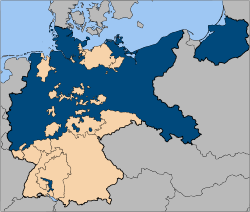- Free State of Prussia (1933–1947)
-
Freistaat Preußen
Free State of PrussiaConstituent state of Nazi Germany ← 
1933–1947 ↓ 

Flag Coat of arms Motto
Gott mit uns!
"God with us!"The Free State of Prussia (blue), within Germany at the time of Nazi Germany. Capital Berlin
52°31′N 13°24′E / 52.517°N 13.4°ECoordinates: 52°31′N 13°24′E / 52.517°N 13.4°EGovernment Constituent state Reichsstatthalter - 1933–1935 Adolf Hitler Minister-President1 - 1933 Franz von Papen - 1933–1935 Hermann Göring Historical era Interwar period - Nazi takeover 30 January 1933 - Dissolution of Prussia 25 February 1947 Area 292,695.36 km2 (113,010 sq mi) Preceded by Succeeded by Free State of Prussia (1918–1933) Gau Kurmark
Gau Eastern Hanover
Gau East Prussia
Gau Magdeburg-Anhalt
Gau Lower Silesia
Gau Pomerania
Gau Southern Hanover-Brunswick
Gau Upper Silesia
Gau Wesser-Ems1: Remained a title until 1945. The Free State of Prussia (German: Freistaat Preußen) briefly continued to exist in name after take-over by the Nazi regime of Adolf Hitler. Unlike the Free State of Prussia that existed from 1918 to 1933 during the Weimar Republic, the Nazi Free State had no parliamentary democracy and was ruled exclusively under the leadership of the National Socialist German Workers Party (Nazi Party). Prussia was administered by high-ranking Nazi member Hermann Göring from 1933 to 1935, who retained the title until 1945, despite the free state being abolished in 1935. Prussia was dismantled into regional Gaue in 1935, ending Prussia as a single territorial unit of Germany.
History
Establishment of Nazi rule in Prussia
On 30 January 1933, Hitler had been appointed chancellor of Germany. As part of the deal, Papen was formally appointed minister-president of Prussia in addition to his role as Vice Chancellor of the Reich. In a little-noticed appointment, Hitler's top lieutenant Hermann Göring became the state's interior minister.
Four weeks later (27 February 1933), the Reichstag was set on fire. At Hitler's urging, President Paul von Hindenburg issued the Reichstag Fire Decree, which suspended civil liberties in Germany. Six days after the fire, the Reichstag election of March 5, 1933 strengthened the position of the Nazi Party, although they did not achieve an absolute majority. However, with their coalition partners, the German National People's Party, Hitler now commanded a bare majority in the Reichstag. Göring figured prominently in this election, as he was commander of the largest police force in the Reich. His police beat and harassed the other parties (especially the Communists and Social Democrats), and only allowed the Nazis and Nationalists to campaign relatively unmolested.
The new Reichstag was opened in the Garrison Church of Potsdam on March 21, 1933 in the presence of President Paul von Hindenburg, who had long since descended into senility. In a propaganda-filled meeting between Hitler and the NSDAP, the "marriage of old Prussia with young Germany" was celebrated, to win over the Prussian monarchists, conservatives, and nationalists and induce them to vote for the Enabling Act. The act was passed on 23 March 1933, legally granting Hitler dictatorial powers.
In April 1933, Papen was visiting the Vatican. The Nazis took advantage of his absence and appointed Göring in his place. With this act, Hitler was able to take power decisively in Germany, since he now had the whole apparatus of the Prussian government, including the police, at his disposal. By 1934 almost all Prussian ministries had been merged with the corresponding Reich ministries.
Dismantlement of Prussia
In the centralized state created by the Nazis in the "Law on the Reconstruction of the Reich ("Gesetz über den Neuaufbau des Reiches", 30 January 1934) and the "Law on Reich Governors" ("Reichsstatthaltergesetz", 30 January 1935) the States and Provinces of Prussia were dissolved, in fact if not in law. The federal state governments were now controlled by governors for the Reich who were appointed by the Chancellor. Parallel to that, the organization of the party into districts (Gau) gained increasing importance, as official in charge of a Gau (the infamous Gauleiter) was again appointed by the Chancellor who was at the same time chief of the NSDAP. Hitler appointed himself formally as Governor of Prussia, although his functions were exercised by Göring.
The leadership positions of Reichsstatthalter and Minister-President which were both held by Hermann Göring continued to exist but were subservient to the Nazi regime. Some changes were still made to Prussian provinces after this time. For example, the Greater Hamburg Act of 1937 transferred some territory from the provinces of Hanover and Schleswig-Holstein to Hamburg while at the same time annexing Hamburgian Geesthacht and the Hanseatic City of Lübeck to Schleswig-Holstein as well as Hamburgian Cuxhaven to the Province of Hanover. Other redeployments took place in 1939, involving cessions of Prusso-Hanoveran suburban municipalities to Bremen and in return the annexation of Bremian Bremerhaven to the Province of Hanover. Also Hanoveran Wilhelmshaven was ceded to Oldenburg. In 1942 redeployments involved the provinces of Saxony and Hanover and the Brunswick.
The Prussian lands transferred to Poland after the Treaty of Versailles were reannexed during World War II. However, most of this territory was not reintegrated back into Prussia but assigned to separate Gaue of the Nazi Germany.
Categories:- States and territories established in 1933
- States and territories disestablished in 1947
Wikimedia Foundation. 2010.

